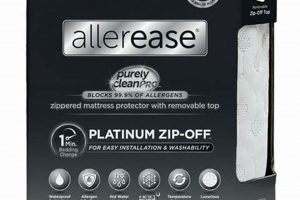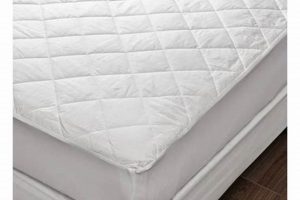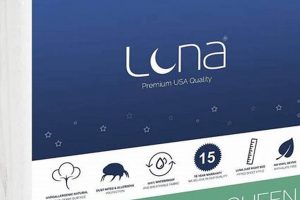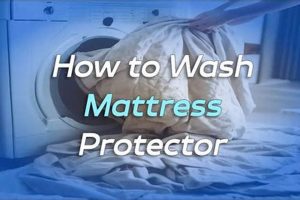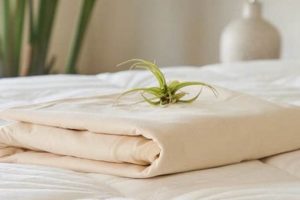An encasement designed to shield a mattress from infestation and prevent existing pests from escaping is commonly employed. These products typically feature a secure closure mechanism that completely seals the mattress. Their primary function is to create a barrier, preventing bed bugs from entering or exiting, thus aiding in eradication and ongoing protection.
The utilization of such protective measures offers several key advantages. It safeguards a significant investment, namely the mattress, from damage and potential disposal due to infestation. Furthermore, these products simplify pest management efforts by limiting the areas where pests can reside. Historically, strategies focused on addressing infestations often required discarding affected mattresses; however, current solutions provide a more sustainable and cost-effective approach.
The subsequent sections will delve into the specific features to consider when selecting an appropriate barrier for mattress protection, discuss maintenance procedures, and outline the role of this protective measure within a comprehensive pest management strategy.
Guidance on Selecting and Utilizing Mattress Encasements
The following provides crucial guidance for effective utilization of mattress encasements to mitigate and prevent infestations.
Tip 1: Prioritize Quality Construction: Examine the encasement’s fabric for tightly woven fibers and robust seams. The integrity of these elements is paramount in preventing pest penetration. A higher thread count typically indicates a more secure barrier.
Tip 2: Verify Zipper Security: Ensure the zipper is durable and closes completely. A locking mechanism or Velcro flap covering the zipper further enhances the seal’s integrity and prevents pests from escaping or entering through this vulnerable point.
Tip 3: Confirm Bed Bug Certified: Seek products specifically labeled as “bed bug proof” or “bed bug certified.” These designations indicate the product has undergone rigorous testing to confirm its effectiveness in blocking pests.
Tip 4: Proper Sizing is Essential: Measure the mattress accurately and select an encasement that fits snugly. Excess fabric can create hiding places for pests, negating the product’s protective benefits. A tight fit is crucial.
Tip 5: Implement Regular Inspection and Maintenance: Routinely inspect the encasement for tears, punctures, or zipper malfunctions. Promptly repair or replace damaged encasements to maintain their protective function. Regular vacuuming of the encasement’s surface is also recommended.
Tip 6: Consider a Box Spring Encasement: For comprehensive protection, encase both the mattress and box spring. Box springs often provide harborage for pests, making their encasement an essential component of a holistic prevention strategy.
Tip 7: Wash Before Initial Use: Washing the encasement before placing it on the mattress can remove any manufacturing residues and ensure a better fit. Follow the manufacturer’s instructions for washing and drying.
By adhering to these recommendations, the effectiveness of mattress encasements in preventing and controlling infestations can be significantly enhanced, preserving mattress integrity and contributing to a healthier sleeping environment.
The subsequent sections will explore integrating mattress encasements into a broader pest management strategy, including preventative measures and professional intervention when necessary.
1. Secure Encasement
The concept of a secure encasement is central to the functionality and effectiveness of zippered bed bug mattress protectors. It is the foundational principle upon which these protective measures are designed, determining their ability to prevent and manage infestations.
- Material Integrity
The material of the encasement must be impervious to penetration by pests. Tightly woven fabrics, such as those with a high thread count or specialized laminations, are crucial. A compromised material allows entry and negates the purpose of the protector. Examples include polyester and microfiber which are strong and durable material for long lasting usage.
- Zipper Reliability
The zipper serves as the primary closure mechanism and represents a potential point of vulnerability. Durable zippers, ideally with a locking feature or a fabric flap covering the zipper line, are essential for maintaining the encasement’s integrity. Weak or easily damaged zippers compromise the barrier.
- Seam Construction
Seams are another potential entry point for pests. Reinforced seams, utilizing techniques like binding or overlocking, enhance the structural integrity and prevent separation. Poorly constructed seams create pathways for pests to enter or escape.
- Proper Fit
The encasement must fit the mattress snugly, without excess material that could create harborage sites for pests. Accurate measurements and a tailored fit are critical for optimal performance. An ill-fitting encasement undermines the protective seal.
In summary, the efficacy of a zippered bed bug mattress protector hinges directly on the robustness of its secure encasement. Each component, from material selection to seam construction, contributes to the overall barrier. Neglecting any aspect of the encasement’s security diminishes its ability to prevent infestations, rendering it largely ineffective.
2. Full Mattress Coverage
The concept of full mattress coverage is inextricably linked to the effectiveness of a zippered bed bug mattress protector. Without complete encasement, the protector’s ability to prevent or contain infestations is significantly compromised. This complete coverage creates a physical barrier, disrupting the life cycle and spread of bed bugs.
- Barrier Against Infestation
Full mattress coverage provides a complete barrier against the ingress of bed bugs into the mattress. Exposed areas serve as entry points, negating the protective benefits. An example includes the bottom of the mattress; if not covered, bed bugs can easily establish themselves. Full coverage eliminates these vulnerabilities.
- Containment of Existing Infestations
If a mattress is already infested, complete coverage traps existing bed bugs within the encasement, preventing them from escaping and spreading to other areas of the room or other furniture. Partial coverage allows bed bugs to migrate freely, undermining eradication efforts. This is crucial for managing existing infestations.
- Protection of All Mattress Surfaces
Mattresses have various surfaces, including the top, sides, and bottom, all of which are susceptible to bed bug activity. Full coverage ensures that each surface is protected, eliminating potential harborage areas. Neglecting the underside, for example, leaves a critical area vulnerable.
- Maintenance of Mattress Hygiene
Complete coverage also aids in maintaining overall mattress hygiene. It protects against dust mites, allergens, and spills, extending the lifespan of the mattress and contributing to a healthier sleep environment. This added benefit makes full coverage a valuable investment.
In conclusion, full mattress coverage is not merely an accessory, but an essential prerequisite for the successful implementation of a zippered bed bug mattress protector. It is the cornerstone upon which the protector’s effectiveness is built, ensuring a comprehensive barrier against both existing and potential infestations. Without it, the protector’s benefits are significantly diminished.
3. Zippered Closure
The zippered closure is an indispensable component of a protective encasement. Its functionality directly impacts the effectiveness of the product in preventing bed bug infestations. This closure serves as the final seal, ensuring complete encasement of the mattress, thereby creating a barrier that prevents both entry and exit of bed bugs. The quality of the zipper mechanism determines the integrity of this barrier. A weak or easily compromised zipper renders the entire encasement ineffective, allowing pests to bypass the protective measure. For example, a standard zipper with large teeth may permit the passage of bed bug nymphs, while a durable, fine-toothed zipper provides a more secure seal. This emphasizes that the quality and design of the closure are critical to the functionality of the encasement.
Real-world applications underscore the significance of the zippered closure. Hotels and residential settings utilizing these encasements rely on the seal to contain infestations and prevent their spread to other areas. If the zipper fails, the entire strategy is jeopardized, potentially leading to widespread infestation and costly remediation efforts. Furthermore, specialized designs, such as those incorporating a locking mechanism or a fabric flap that covers the zipper, offer enhanced security. These features address the potential for accidental opening or subtle gaps, reinforcing the barrier against pest intrusion. This demonstrates how design innovations contribute to the practical effectiveness of these protectors.
In summary, the zippered closure is not merely an incidental feature, but a critical element that dictates the success or failure of a protective encasement. A robust and well-designed closure is essential for maintaining a secure seal, preventing infestations, and preserving the integrity of the mattress. Challenges associated with zipper durability and design underscore the need for manufacturers to prioritize quality and incorporate innovative solutions to ensure the ongoing effectiveness of these protective measures. The zippered closure connects directly to the overarching goal of maintaining a pest-free sleeping environment.
4. Pest Prevention
The primary function of a zippered bed bug mattress protector resides in its capacity for pest prevention. This preventive measure directly mitigates the establishment and proliferation of bed bug infestations within a mattress. A secure encasement interrupts the life cycle of these pests by denying them access to their primary harborage and breeding ground. Without this physical barrier, mattresses become vulnerable to infestation, resulting in significant economic and health-related consequences.
The efficacy of pest prevention through zippered mattress protectors extends beyond mere containment. These protectors prevent initial infestations in previously unexposed mattresses, safeguarding a substantial investment. Conversely, in cases where mattresses are already infested, the protectors serve to contain the existing population, preventing their migration to other areas within the dwelling. Hotels, for instance, utilize these protectors not only to shield mattresses from potential infestations but also to comply with health and safety standards, minimizing the risk of pest-related complaints and legal ramifications.
In summary, the link between pest prevention and zippered bed bug mattress protectors is causal and integral. The protectors act as a first line of defense, preventing infestations, containing existing populations, and reducing the need for costly and disruptive pest control interventions. Understanding this relationship is vital for informed decision-making in both residential and commercial settings, underscoring the protector’s role as a practical and proactive pest management tool.
5. Hypoallergenic Barrier
The incorporation of a hypoallergenic barrier within a zippered bed bug mattress protector serves a dual purpose: mitigating allergic reactions and enhancing overall sleep hygiene. This barrier, typically composed of tightly woven materials, prevents the accumulation of dust mites, pet dander, and other allergens within the mattress. The absence of such a barrier can exacerbate respiratory ailments, eczema, and other allergy-related conditions. Consequently, the presence of a hypoallergenic layer transforms the protector from a simple pest-control device into a health-promoting sleep surface. For instance, individuals with diagnosed dust mite allergies experience a marked reduction in symptoms when using a protector equipped with this feature. This illustrates the direct cause-and-effect relationship between the barrier and improved well-being.
The selection of materials for the hypoallergenic barrier is critical. Synthetic fabrics, such as microfiber or polyester, are commonly employed due to their inherent allergen-resistant properties. These materials create a physical barrier that prevents allergens from penetrating the mattress core, where they can accumulate and thrive. In contrast, protectors made from natural fibers, unless specifically treated, may not offer the same level of protection against allergen accumulation. Hospitals and healthcare facilities frequently utilize protectors with hypoallergenic barriers to minimize patient exposure to allergens and create a cleaner, healthier environment. This practice highlights the recognition of the hypoallergenic barrier as an essential component of a comprehensive hygiene strategy.
In summary, the hypoallergenic barrier represents a vital component of a zippered bed bug mattress protector. Its inclusion not only reduces the risk of allergic reactions but also contributes to a cleaner and more hygienic sleep environment. The selection of appropriate materials and the recognition of its practical benefits underscore its importance in both residential and commercial settings. While the primary function of the protector remains pest control, the hypoallergenic barrier adds significant value by promoting health and well-being, thereby transforming it into a multifaceted sleep solution. The challenge lies in ensuring the long-term efficacy of the barrier through proper maintenance and care, including regular washing and inspection.
6. Durable Material
The selection of durable materials is paramount in the manufacture of effective zippered bed bug mattress protectors. Material durability directly influences the protector’s longevity, resistance to damage, and ability to consistently perform its intended function of preventing pest infestations.
- Resistance to Tearing and Punctures
Durable materials exhibit high resistance to tearing and punctures, which are critical for maintaining an impenetrable barrier against bed bugs. Everyday wear and tear, such as shifting during sleep or accidental contact with sharp objects, can compromise weaker materials. Materials like tightly woven polyester or laminated fabrics offer superior protection against such damage, ensuring the protector remains intact and effective over time.
- Withstanding Repeated Washing
Mattress protectors require regular washing to maintain hygiene and remove allergens. Durable materials are capable of withstanding repeated wash cycles without significant degradation in their protective properties. Materials that shrink, fade, or lose their structural integrity after washing compromise the protector’s fit and effectiveness. Quality materials retain their shape and barrier function even after numerous washes, contributing to the protector’s overall lifespan.
- Resistance to Abrasion
Abrasion resistance refers to a material’s ability to withstand friction and rubbing without wearing down. Mattress protectors are subjected to constant abrasion from sheets, blankets, and body movements. Durable materials, such as those with a high thread count or reinforced construction, resist abrasion better than weaker alternatives, preventing the formation of thin spots or holes that could allow bed bugs to penetrate.
- Longevity and Cost-Effectiveness
The use of durable materials directly translates to increased longevity and cost-effectiveness. While protectors made from less durable materials may have a lower initial cost, they require more frequent replacement due to damage or degradation. Durable protectors, although potentially more expensive upfront, offer a longer lifespan, resulting in lower overall costs and reduced environmental impact. This long-term value makes durable materials a critical consideration for consumers.
In conclusion, the integration of durable materials into the construction of zippered bed bug mattress protectors is essential for ensuring long-term effectiveness and value. Resistance to tearing, punctures, washing, and abrasion are key material properties that contribute to the protector’s ability to consistently prevent infestations and maintain hygiene. Prioritizing durable materials represents a sound investment in both mattress protection and overall sleep health.
Frequently Asked Questions About Zippered Bed Bug Mattress Protectors
This section addresses common inquiries and clarifies misconceptions regarding zippered bed bug mattress protectors. The information provided is intended to offer comprehensive insights into their usage, benefits, and limitations.
Question 1: Are all zippered mattress protectors equally effective against bed bugs?
No. Effectiveness varies significantly depending on material quality, weave density, zipper construction, and overall design. Protectors marketed solely for allergen control may not possess the necessary features to prevent bed bug penetration or escape. Seek products specifically labeled as “bed bug proof” or “bed bug certified” to ensure adequate protection.
Question 2: How often should a zippered bed bug mattress protector be washed?
Washing frequency depends on usage and environmental factors. In general, washing every 2-3 months is recommended. However, more frequent washing may be necessary in cases of heavy sweating, spills, or suspected pest activity. Always follow the manufacturer’s instructions for washing and drying to prevent damage to the protector.
Question 3: Can a zippered mattress protector eliminate an existing bed bug infestation?
A zippered mattress protector alone cannot eliminate an existing infestation. It primarily serves to contain the infestation within the mattress, preventing further spread. Effective eradication requires a comprehensive pest management strategy, which may include professional pest control services, vacuuming, laundering, and the use of appropriate insecticides.
Question 4: What are the key features to look for when purchasing a zippered bed bug mattress protector?
Essential features include a tightly woven fabric with a pore size small enough to prevent bed bug penetration, a durable zipper with a locking mechanism or fabric flap, reinforced seams, and a snug fit that completely encases the mattress. Certification from a reputable testing laboratory is also a valuable indicator of effectiveness.
Question 5: Are zippered mattress protectors only useful for bed bug control?
No. In addition to bed bug prevention, these protectors offer several other benefits, including protection against dust mites, allergens, and spills. They also help to maintain mattress hygiene and extend its lifespan. The multi-functional nature of these protectors makes them a valuable investment for overall sleep health.
Question 6: How should a zippered bed bug mattress protector be installed to ensure maximum effectiveness?
Installation involves carefully unzipping the protector, sliding it over the mattress, and ensuring that all surfaces are completely covered. The zipper should be fully closed and secured with any locking mechanism or fabric flap provided. Regular inspection for tears, punctures, or zipper malfunctions is essential for maintaining its protective function.
In conclusion, zippered bed bug mattress protectors are a valuable tool for preventing and managing bed bug infestations, as well as maintaining mattress hygiene and reducing allergen exposure. However, their effectiveness depends on proper selection, installation, and maintenance, as well as integration into a comprehensive pest management strategy when dealing with existing infestations.
The following sections will provide guidance on selecting the appropriate type and size of mattress protector for specific needs and circumstances.
Zippered Bed Bug Mattress Protectors
This exposition has detailed the critical attributes and functionality of zippered bed bug mattress protectors. The investigation encompassed material quality, construction standards, and the imperative of complete mattress encasement. It further emphasized the necessity of secure closure mechanisms and the significance of these protectors within a comprehensive pest management strategy. This analysis underscores that a properly selected and maintained protector offers a tangible barrier against infestation and contributes to a more hygienic sleep environment.
The information presented serves as a crucial resource for informed decision-making. Prudent assessment and diligent implementation of these protective measures represent a proactive step toward mitigating the risks associated with bed bug infestations. Continued vigilance and adherence to best practices remain essential for sustained effectiveness.


